Max Warasila
Member
Hi,
By now, some of you might have noticed the picture wreaking havoc across the internet of a BLUE AND BROWN colored dress that many people see as either BLUE AND BLACK or WHITE AND GOLD. I took some time and dove into it on Facebook, but I thought you all might have some fun hearing about it here.
First, the image:

The dress in question here is actually this one, which is, in reality, BLUE AND BLACK: http://www.amazon.co.uk/dp/B00SJEUCWU/?tag=contro0a-21
But people are seeing it as white and gold? What on earth is going on here?
I like empirical data, so I went and got myself some. Here is the definitive answer on what the colors actually are, ignoring all relative perception: The darker areas are a dark tone of gold/brown (a tone is the color with gray added). The lighter areas are blue. The washed out background is white or off white towards yellow. I've included an image with numerous samples points below. Plug them into any color picking application and see for yourself.

I remind you that even though the real dress is blue and black, we don't know that just looking at this image. For that reason, it doesn't matter what color the dress initially was - we only perceive what is here and now in this image.
I'm a lighting designer, and spent a good year of my life just comparing colors. I'm no colorist, but from my trained eye I see blue and black immediately, and upon closer inspection see that it's actually a tone of gold/brown. I have looked at this image on five screens, varying the color from lowest brightness all the way to brightest. Two of the screens are color calibrated to be CIE1934 accurate. The colors stay the same for me, though I lose the gold/brown perception at very low levels due to the reduction in color sensitivity at lower light levels. My eyes are very pale blue, in case anyone thinks that might have impacted it. My parents see white/gold. My brother and I see blue/dark brown. We all have blue eyes.
Now, down to explanation time:
The colors in this photo are very, very desaturated. Below is a double saturation version of the image. Unlike contrast, which increases the brightness variations, the saturation adjustment used here calculates the hue and then spreads out the primaries to show the true color.

As we can see, it's blue and... well, I guess we can call that color bronze. Most people will see it about as gold. But what is causing the total misperception?
There are a few causes. The first is the lack of quality between screen primaries and gamma calibrations. Some screens will not properly display the colors. This is, however, the least of our worries, as it just shifts the colors instead of wildly changing them.
Second, we have the fact that these are complimentary colors, the brighter of which is blue. As we all know from our color and lighting theory, light fits into a key role or a fill role most of the time, and our particular key light is special. The key light of a visual determines what our brain and eyes will attempt to see as "white." When our eyes shift the blue towards white (as it is very low saturation and doesn't take much effort at all - the color is only 15 points of HSB saturation away from no color), our brain will shift the entire scene further towards the warm end of the color temperature correction curve, meaning that the gold will become even MORE gold. This is an effect that occurs normally over time, but can happen rapidly, especially when the key light is so close to simply being off white.
Third, and perhaps most interestingly, our eyes themselves are at fault. As a species we see rather well, but we do not agree on what we see as readily as we agree on a mathematics answer. Our eyes are made up of rods and cones. Rods see black and white, cones see color, divided up into either red, green, and naked peopl- I mean, blue. Of those three, our blue cones are the weakest in their color range because they are responsible for so much of it - if we look at a chart of what our cones each see, you might even feel sorry for the little guys:

The blues are all by themselves, and take a beating from higher energy wavelengths in the cyan, blue, indigo, violet, and ultra violet areas of the spectrum. Most likely, from the sample set of people I've observed, the issue can be caused just as much by aging cones as random genetics.
When we combine all these factors, we can see how the issue arises. However, what if the image were a different set of hues, like below?

I think we can all agree that the dress is either a rose, pink or, more accurately, magenta, and, if we look close enough, the apparent black is actually toned towards a mint green. If you aren't sure, it's saturated more below:

Cool, huh? Always remember the effects of your color choices might have on the perception of your scene. Even if we might (or might not) notice a particular set of colors and their interactions, we have no guarantee that other people will agree with us.
Thank you all for your time. I will edit in answers to questions and corrections as they come up. Happy Hunting!
By now, some of you might have noticed the picture wreaking havoc across the internet of a BLUE AND BROWN colored dress that many people see as either BLUE AND BLACK or WHITE AND GOLD. I took some time and dove into it on Facebook, but I thought you all might have some fun hearing about it here.
First, the image:
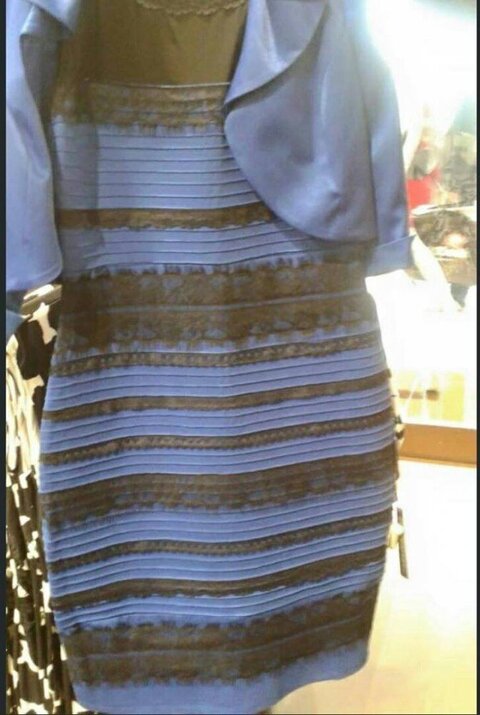
The dress in question here is actually this one, which is, in reality, BLUE AND BLACK: http://www.amazon.co.uk/dp/B00SJEUCWU/?tag=contro0a-21
But people are seeing it as white and gold? What on earth is going on here?
I like empirical data, so I went and got myself some. Here is the definitive answer on what the colors actually are, ignoring all relative perception: The darker areas are a dark tone of gold/brown (a tone is the color with gray added). The lighter areas are blue. The washed out background is white or off white towards yellow. I've included an image with numerous samples points below. Plug them into any color picking application and see for yourself.
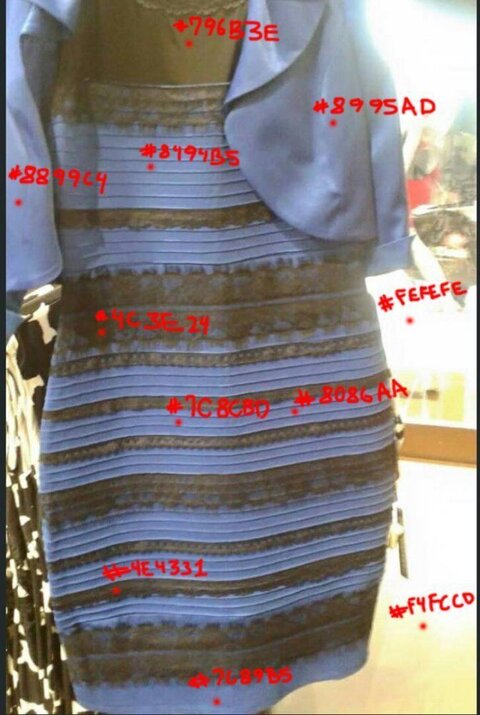
I remind you that even though the real dress is blue and black, we don't know that just looking at this image. For that reason, it doesn't matter what color the dress initially was - we only perceive what is here and now in this image.
I'm a lighting designer, and spent a good year of my life just comparing colors. I'm no colorist, but from my trained eye I see blue and black immediately, and upon closer inspection see that it's actually a tone of gold/brown. I have looked at this image on five screens, varying the color from lowest brightness all the way to brightest. Two of the screens are color calibrated to be CIE1934 accurate. The colors stay the same for me, though I lose the gold/brown perception at very low levels due to the reduction in color sensitivity at lower light levels. My eyes are very pale blue, in case anyone thinks that might have impacted it. My parents see white/gold. My brother and I see blue/dark brown. We all have blue eyes.
Now, down to explanation time:
The colors in this photo are very, very desaturated. Below is a double saturation version of the image. Unlike contrast, which increases the brightness variations, the saturation adjustment used here calculates the hue and then spreads out the primaries to show the true color.
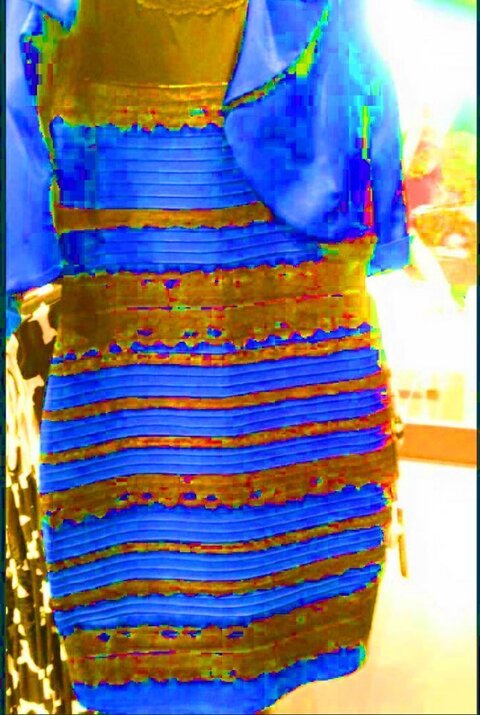
As we can see, it's blue and... well, I guess we can call that color bronze. Most people will see it about as gold. But what is causing the total misperception?
There are a few causes. The first is the lack of quality between screen primaries and gamma calibrations. Some screens will not properly display the colors. This is, however, the least of our worries, as it just shifts the colors instead of wildly changing them.
Second, we have the fact that these are complimentary colors, the brighter of which is blue. As we all know from our color and lighting theory, light fits into a key role or a fill role most of the time, and our particular key light is special. The key light of a visual determines what our brain and eyes will attempt to see as "white." When our eyes shift the blue towards white (as it is very low saturation and doesn't take much effort at all - the color is only 15 points of HSB saturation away from no color), our brain will shift the entire scene further towards the warm end of the color temperature correction curve, meaning that the gold will become even MORE gold. This is an effect that occurs normally over time, but can happen rapidly, especially when the key light is so close to simply being off white.
Third, and perhaps most interestingly, our eyes themselves are at fault. As a species we see rather well, but we do not agree on what we see as readily as we agree on a mathematics answer. Our eyes are made up of rods and cones. Rods see black and white, cones see color, divided up into either red, green, and naked peopl- I mean, blue. Of those three, our blue cones are the weakest in their color range because they are responsible for so much of it - if we look at a chart of what our cones each see, you might even feel sorry for the little guys:
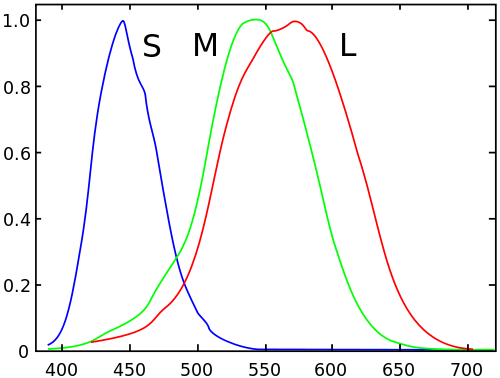
The blues are all by themselves, and take a beating from higher energy wavelengths in the cyan, blue, indigo, violet, and ultra violet areas of the spectrum. Most likely, from the sample set of people I've observed, the issue can be caused just as much by aging cones as random genetics.
When we combine all these factors, we can see how the issue arises. However, what if the image were a different set of hues, like below?
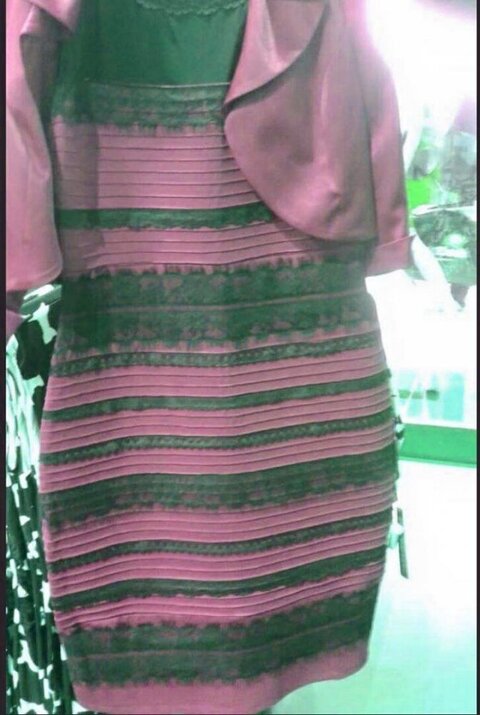
I think we can all agree that the dress is either a rose, pink or, more accurately, magenta, and, if we look close enough, the apparent black is actually toned towards a mint green. If you aren't sure, it's saturated more below:
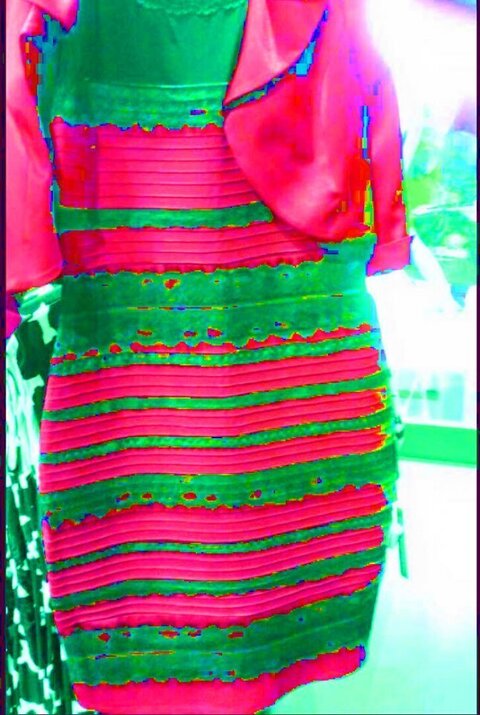
Cool, huh? Always remember the effects of your color choices might have on the perception of your scene. Even if we might (or might not) notice a particular set of colors and their interactions, we have no guarantee that other people will agree with us.
Thank you all for your time. I will edit in answers to questions and corrections as they come up. Happy Hunting!


